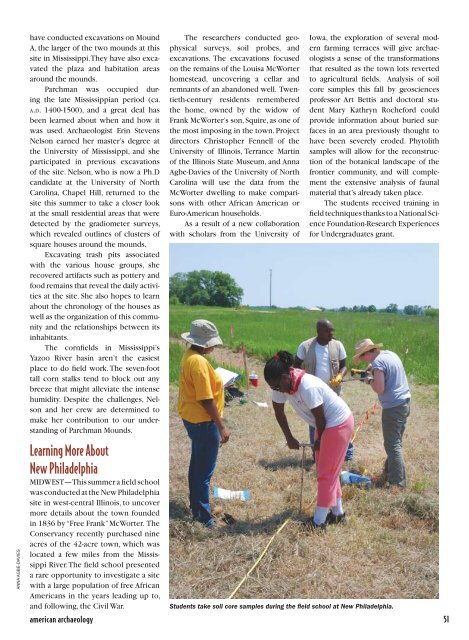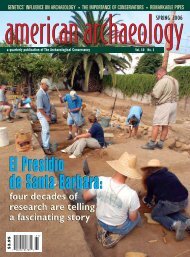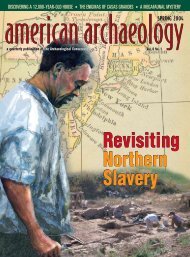Clovis Comet Debate - The Archaeological Conservancy
Clovis Comet Debate - The Archaeological Conservancy
Clovis Comet Debate - The Archaeological Conservancy
You also want an ePaper? Increase the reach of your titles
YUMPU automatically turns print PDFs into web optimized ePapers that Google loves.
anna agbe-daVieS<br />
have conducted excavations on Mound<br />
A, the larger of the two mounds at this<br />
site in Mississippi. <strong>The</strong>y have also excavated<br />
the plaza and habitation areas<br />
around the mounds.<br />
Parchman was occupied during<br />
the late Mississippian period (ca.<br />
a.d. 1400-1500), and a great deal has<br />
been learned about when and how it<br />
was used. Archaeologist Erin Stevens<br />
Nelson earned her master’s degree at<br />
the University of Mississippi, and she<br />
participated in previous excavations<br />
of the site. Nelson, who is now a Ph.D<br />
candidate at the University of North<br />
Carolina, Chapel Hill, returned to the<br />
site this summer to take a closer look<br />
at the small residential areas that were<br />
detected by the gradiometer surveys,<br />
which revealed outlines of clusters of<br />
square houses around the mounds.<br />
Excavating trash pits associated<br />
with the various house groups, she<br />
recovered artifacts such as pottery and<br />
food remains that reveal the daily activities<br />
at the site. She also hopes to learn<br />
about the chronology of the houses as<br />
well as the organization of this community<br />
and the relationships between its<br />
inhabitants.<br />
<strong>The</strong> cornfields in Mississippi’s<br />
Yazoo River basin aren’t the easiest<br />
place to do field work. <strong>The</strong> seven-foot<br />
tall corn stalks tend to block out any<br />
breeze that might alleviate the intense<br />
humidity. Despite the challenges, Nelson<br />
and her crew are determined to<br />
make her contribution to our understanding<br />
of Parchman Mounds.<br />
Learning more About<br />
New Philadelphia<br />
MIDWEST—This summer a field school<br />
was conducted at the New Philadelphia<br />
site in west-central Illinois, to uncover<br />
more details about the town founded<br />
in 1836 by “Free Frank” McWorter. <strong>The</strong><br />
<strong>Conservancy</strong> recently purchased nine<br />
acres of the 42-acre town, which was<br />
located a few miles from the Mississippi<br />
River. <strong>The</strong> field school presented<br />
a rare opportunity to investigate a site<br />
with a large population of free African<br />
Americans in the years leading up to,<br />
and following, the Civil War.<br />
<strong>The</strong> researchers conducted geophysical<br />
surveys, soil probes, and<br />
excavations. <strong>The</strong> excavations focused<br />
on the remains of the Louisa McWorter<br />
homestead, uncovering a cellar and<br />
remnants of an abandoned well. Twentieth-century<br />
residents remembered<br />
the home, owned by the widow of<br />
Frank McWorter’s son, Squire, as one of<br />
the most imposing in the town. Project<br />
directors Christopher Fennell of the<br />
University of Illinois, Terrance Martin<br />
of the Illinois State Museum, and Anna<br />
Agbe-Davies of the University of North<br />
Carolina will use the data from the<br />
McWorter dwelling to make comparisons<br />
with other African American or<br />
Euro-American households.<br />
As a result of a new collaboration<br />
with scholars from the University of<br />
Iowa, the exploration of several modern<br />
farming terraces will give archaeologists<br />
a sense of the transformations<br />
that resulted as the town lots reverted<br />
to agricultural fields. Analysis of soil<br />
core samples this fall by geosciences<br />
professor Art Bettis and doctoral student<br />
Mary Kathryn Rocheford could<br />
provide information about buried surfaces<br />
in an area previously thought to<br />
have been severely eroded. Phytolith<br />
samples will allow for the reconstruction<br />
of the botanical landscape of the<br />
frontier community, and will complement<br />
the extensive analysis of faunal<br />
material that’s already taken place.<br />
<strong>The</strong> students received training in<br />
field techniques thanks to a National Science<br />
Foundation-Research Experiences<br />
for Undergraduates grant.<br />
Students take soil core samples during the field school at New Philadelphia.<br />
american archaeology 51




